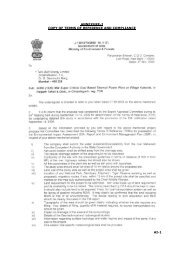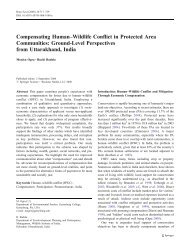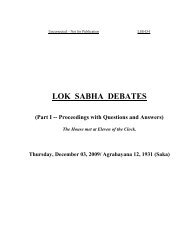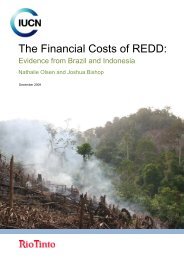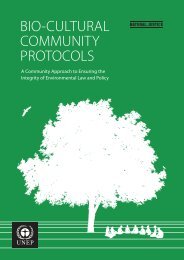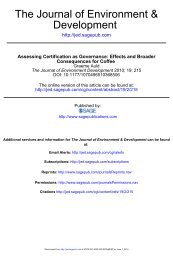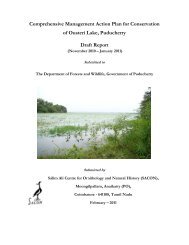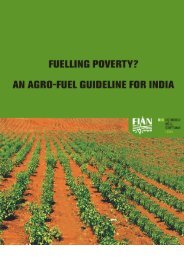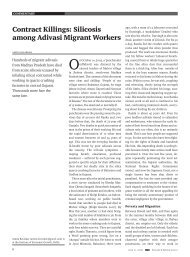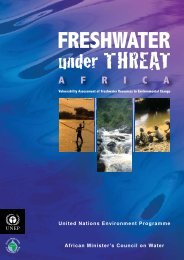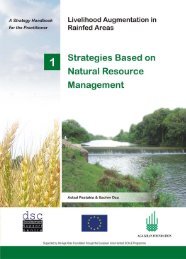Integrated River Basin Planning – Replicable ... - India Water Portal
Integrated River Basin Planning – Replicable ... - India Water Portal
Integrated River Basin Planning – Replicable ... - India Water Portal
You also want an ePaper? Increase the reach of your titles
YUMPU automatically turns print PDFs into web optimized ePapers that Google loves.
<strong>Integrated</strong> <strong>River</strong> <strong>Basin</strong> <strong>Planning</strong>: <strong>India</strong> and the EU share experience on policy and practice<br />
Annex<br />
Surface <strong>Water</strong>, Fish <strong>Water</strong>, Shellfish <strong>Water</strong>, Bathing <strong>Water</strong> and Drinking <strong>Water</strong><br />
Directives) or establish emission limit values for specific water uses (e.g. Dangerous<br />
Substances Directive and the old Groundwater Directive).<br />
The second major period of EU water legislation, between 1980 and 1991,<br />
introduced additional Directives controlling discharges of pollutants to the water<br />
environment, including the Nitrates Directive, the Urban Waste <strong>Water</strong> Treatment<br />
Directive, the <strong>Integrated</strong> Pollution Prevention and Control (IPPC) Directive, as well<br />
as several sub-Directives implementing the Dangerous Substances Directive.<br />
These second-period Directives mainly followed the Emission Limit Value (ELV)<br />
approach with respect to water pollution control at the source, both from point<br />
and diffuse sources. However, this piecemeal evolution on a case-by-case basis<br />
had led to a complex picture of <strong>Water</strong> Directives with differing and often conflicting<br />
methodologies, definitions and aims.<br />
Furthermore, the <strong>Water</strong> Directives were often less successful in environmental<br />
outcome than expected. The need for new and more coordinated EU water<br />
legislation was recognised, and a major revision of EU water policy was launched,<br />
finally resulting in the adoption of the <strong>Water</strong> Framework Directive (WFD) 2000/60/<br />
EC. The WFD provides a framework for the protection of all water bodies and<br />
applies a combined approach of WQOs and ELVs plus a number of overarching<br />
principles determining current EU water policies, as illustrated in Text Box 1 below.<br />
Text Box 1<br />
Important principles determining current EU water policy<br />
High level of protection: Taking into account the diversity of situations in the various regions of the Community<br />
Precautionary principle: Where there are threats of serious or irreversible environmental damage, lack<br />
of full scientific certainty should not be used as a reason for postponing cost-effective measures to prevent<br />
environmental degradation<br />
Preventive principle: Allows action to be taken to protect the environment at an early stage, before actual<br />
damage has occurred<br />
Rectification of pollution at source: Specifies that environmental damage should preferably be prevented at<br />
the source rather than by using ‘end-of-pipe technology’ (implies a preference for ELV rather than WQO approach)<br />
Polluter pays principle: Those who cause pollution should meet the costs to which it gives rise<br />
User pays principle: Calls upon the user of water to pay for the full cost, including capital, operation,<br />
maintenance, environmental costs and other externalities<br />
Integration of environmental protection into other sector policies; e.g. agriculture, transport and energy<br />
Subsidiarity principle: Encourages decisions and actions to be made at the lowest appropriate level. “Objectives<br />
at central level <strong>–</strong> plans and measures at local level”.<br />
All these principles are reflected in the WFD. Placing these principles at the<br />
centre of water policy has major implications for further policy development and<br />
implementation, as they support the following policy objectives and elements of the<br />
WFD:<br />
• The development of integrated policies for the long-term sustainable use of<br />
water, and its application in accordance with the principle of subsidiarity;<br />
• Expanding the scope of water protection to all water: surface water,<br />
including coastal water, and groundwater;<br />
• <strong>Water</strong> management based on river basins, with appropriate co-ordination<br />
provisions for international river basin districts;<br />
• Setting prices for water use, taking into account the principle of cost<br />
recovery and in accordance with the polluter pays principle;<br />
• Encouraging greater participation by citizens; and<br />
• Streamlining legislation.<br />
An overview of existing water-related legislation is provided in Text Box 2.<br />
Text Box 2<br />
EU water related legislation<br />
The Framework Legislation<br />
• <strong>Water</strong> Framework Directive (WFD) (2000/60/EC).<br />
<strong>Water</strong> Quality Objective oriented<br />
• Bathing <strong>Water</strong> Directive (76/160/EEC; to be repealed and replaced by the new Bathing Directive 2006/7/EC at<br />
the latest by 2014).<br />
• Drinking <strong>Water</strong> Directive (98/83/EC).<br />
• Directive on Surface for Drinking <strong>Water</strong> Abstraction (75/440/EEC; <strong>Integrated</strong> into the WFD, to be repealed<br />
under the WFD 2000/60/EC as from 22.12.07).<br />
• Freshwater Fish Directive (78/659/EEC); integrated into the WFD, to be repealed under the WFD 2000/60/EC<br />
as from 22.12.13).<br />
• Shelfish <strong>Water</strong> Directive (79/923/EEC; integrated into the WFD, to be repealed under the WFD 2000/60/EC as<br />
from 22.12.13).<br />
Emission-Control oriented<br />
• Urban Waste <strong>Water</strong> Treatment Directive (91/271/EEC) and related Decision 93/481/EEC.<br />
• Nitrates Directive (91/676/EEC).<br />
• Ground <strong>Water</strong> Directive (80/68/EEC; integrated into the WFD, to be repealed under the WFD 2000/60/EC<br />
as from 22.12.13; after 2013 the protection regime should be continued through the WFD and the new<br />
Groundwater Daughter Directive (2006/118/EC) adopted on 12/12/2006).<br />
• Dangerous Substances Directive (76/464/EEF; to be repealed under the WFD 2000/60/EC as from 22.12.2013;<br />
proposal for a new Directive setting limites for 41 substances was adopted on 17/07/2006 (COM(2006)397<br />
final)).<br />
• Daughter Directives of the Dangerous Substances Directive (to be replaced and repealed under the Directive<br />
proposed 17/07/2006).<br />
• <strong>Integrated</strong> Pollution Prevention and Control Directive (96/61/EC).<br />
Diffuse source emission controls<br />
• Plant Protection Products (91/414/EC).<br />
• Marketing and Use of Dangerous Substances and Preparations (76/769/EEC).<br />
• Biocides (98/8/EC).<br />
Monitoring and Reporting<br />
• Directive on the Measurement of Surface (Drinking) <strong>Water</strong> (79/869/EEC; to be repealed under the WFD<br />
2000/60/EC as from 22.12.07).<br />
• Common Procedures for Exchange of Information (Decision 77/795/EEC).<br />
Source: Handbook on the Implementation of EC Environmental Legislation; Guide on Convergence with EU Environmental Legislation in Eastern Europe, Caucasus and<br />
Central Asia.<br />
• Achieving “good status” for all water by a certain deadline, and preserving<br />
such a status where it already exists;<br />
74 75



